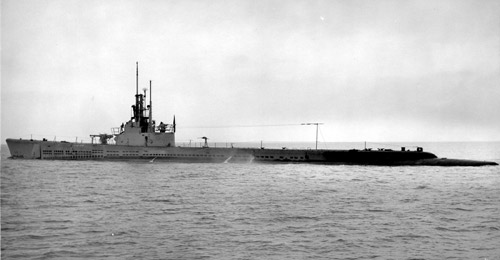Gato-class (SS-212)
Summary
| Origin country | 🇺🇸 United States |
| Category | Submarine |
| Subtype | Attack submarine (World War II) |
| Manufacturer | Electric Boat Company, Portsmouth Naval Shipyard, Mare Island Naval Shipyard, Manitowoc Shipbuilding Company |
| Year commissioned | 1941 |
Description
The USS Gato (SS-212) served as the lead ship of the Gato-class submarines in the United States Navy and was named after the catshark. Commissioned shortly after the outbreak of World War II, the submarine played a critical role in naval warfare and underwent thirteen combat patrols throughout the conflict.
Constructed by the Electric Boat Company in Connecticut, the USS Gato's origins date back to its keel laying on October 5, 1940, and subsequent launch on August 21, 1941. It was sponsored by the wife of Admiral Royal E. Ingersoll and commissioned into service on December 31, 1941.
The design of the USS Gato was typical of the United States Navy's fleet submarines of the era. While specific armaments are not listed in the provided text, it is inferred that Gato was armed with torpedoes, which were used to engage enemy vessels during its patrols, and deck guns, as demonstrated by the several surface engagements mentioned.
Gato’s operational history began with a shakedown cruise followed by additional training in San Francisco. Early in her service, while near San Francisco Bay, Gato was mistakenly attacked by a US Navy blimp, which caused significant damage, but the submarine sustained no casualties. Following repairs, Gato moved to Pearl Harbor to commence her first combat patrol.
Over the course of World War II, Gato conducted numerous war patrols across the Pacific, engaging in combat and intelligence operations. Highlights include the Battle of Midway, operations in the Kurile Islands, and engagements near the Solomons. Gato's role varied from offensive strikes against enemy shipping to the evacuation of civilians and rescue of downed airmen.
Notably, her seventh patrol involved a coordinated attack resulting in the sinking of the Columbia Maru and a daring escape from a depth charge attack. Her eighth patrol included the sinking of multiple enemy vessels and the rescue of airmen. The 11th patrol saw further success with the sinking of a coast defense ship and enemy cargo vessel within a wolfpack tactically operating in the Yellow Sea.
Her 13th and final combat patrol was conducted in support of air strikes on Wake Island, and, coinciding with the war's end, Gato was present in Tokyo Bay for the signing of the surrender documents onboard the USS Missouri on September 2, 1945.
Post-war, Gato was relegated to the role of a training vessel until it was decommissioned in 1946. After years serving as a Naval Reserve training ship, it was eventually struck from the Naval Vessel Register and sold for scrapping in 1960.
In recognition of her wartime service, Gato received numerous honors, including the Presidential Unit Citation and 13 battle stars on her Asiatic-Pacific Campaign Medal. Her legacy continued post-war in media portrayals, such as the series "The Silent Service," where the Gato-story was featured, and in the film "Up Periscope," which utilized footage of a Gato-class submarine.
Technical specifications
| Gato | |
|---|---|
| Displacement | 1549 tons |
| Displacement submerged | 2463 tons |
| Range | 11000 km at 10 knots |
| Endurance | 75 days on patrol |
| Crew | 60 members |
| Width | 8.31 m (27.3 ft) |
| Length | 95.02 m (311.7 ft) |
| Max. depth | 90 m (295.3 ft) |
| Propulsion | 4 Fairbanks-Morse diesel engines with a power of 5,400 hp (surface) + 4 electric motors of 2,740 hp (submerged) - 2 propellers |
| Armament | 6 front torpedo tubes + 4 rear torpedo tubes + 24 torpedoes in storage + 1 76mm gun + 1 40mm Bofors gun + 1 20mm Oerlikon gun |
| Maximum speed | 21 knots |
| Max. speed submerged | 9 knots |
Photo of Gato class

Silhouette
